Union of Horodło
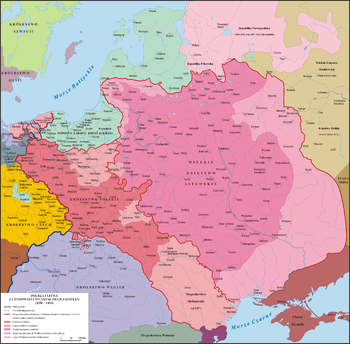
The Union of Horodło or Pact of Horodło was a set of three acts signed in the town of Horodło on 2 October 1413. The first act was signed by Władysław II Jagiełło, King of Poland, and Vytautas, Grand Duke of Lithuania. The second and third acts were composed by the Polish nobility (szlachta) and Lithuanian boyars respectively.[1] The union amended the earlier Polish–Lithuanian unions of Krewo and Vilnius–Radom. Politically, Lithuania received more autonomy as, after the death of Vytautas, the Lithuanian nobles could choose another Grand Duke instead of passing the title to Władysław II Jagiełło or his heir. However, culturally, Lithuania and Poland grew closer. Lithuania adopted Polish institutions of castellans and voivodes. Catholic Lithuanian nobles and church officials were granted equal rights with the Polish nobles and clergy. Forty-seven selected Lithuanian nobles were adopted by Polish families and granted Polish coats of arm. Thus the union signified the beginnings of Polonization of Lithuanian culture and the rise of the Lithuanian nobility. It was one of the major steps towards the modernization and Europeanization of Lithuania.[2]
Historical background
Poland and Lithuania had been joined in a personal union since the Union of Krewo of 1385. Both countries were ruled by Władysław II Jagiełło. However, after the Lithuanian Civil War (1389–1392) and the Ostrów Agreement, Vytautas gained the supreme power in Lithuania.[3] The legal basis for Polish–Lithuanian relations was revisited by the Union of Vilnius and Radom of 1401, which reiterated de facto Lithuanian independence and de jure Polish supremacy. Vytautas was to be known by the title of Grand Duke (magnus dux) and enjoyed vast power in Lithuania, while technically he was subordinate to Władysław II Jagiełło, 'Greatest Duke' (supremus dux) and King of Poland.[2] The union was signed after Vytautas' army was soundly defeated in the Battle of the Vorskla River and weakened Lithuania was looking for Polish support.[3] Taking advantage of the Lithuanian defeat, the Principality of Smolensk, Veliky Novgorod, and Pskov rebelled against Lithuanian rule, drawing Vytautas into a war with the Grand Duchy of Moscow.[4] However, within a few years peace was re-established in the east.
In 1409, the second Samogitian uprising against the Teutonic Knights escalated into the Polish–Lithuanian–Teutonic War. Joint Polish–Lithuanian forces defeated the Knights in the decisive Battle of Grunwald in 1410. However, the war did not resolve all the disputes and by 1413 Poland–Lithuania was preparing for another war with the Knights (see Hunger War).[2][5] These developments encouraged Poland and Lithuania to review their relationship.
Provisions
The treaty repeated the indissoluble character of the Polish–Lithuanian union while carefully balancing Polish and Lithuanian interests. The Lithuanians gained more autonomy as they received the right to elect a new Grand Duke after the death of Vytautas.[2] The earlier Union of Vilnius and Radom stipulated that Lithuania would pass to Władysław II Jagiełło or his heir. However, the Lithuanian nobles promised to consult the Polish nobles when choosing a successor to Vytautas. The reverse was also true: the Polish nobles promised to consult with the Lithuanians when electing the next Polish King.[1] The pact contained one of the first mentions of the Seimas of the Grand Duchy of Lithuania. The Polish and Lithuanian nobles agreed to hold a joint general sejm to discuss all major matters, but such a sejm did not take place until 1564.[1] Nevertheless, it was a recognition of the political powers of the Lithuanian nobles.[2]
The Lithuanian nobles and clergy were granted equal rights with the Polish nobility and clergy.[6] However, this extended only to Catholics; many Ruthenian nobles, who were Eastern Orthodox, were excluded.[7] Selected Lithuanian nobles, 47 in total, were adopted into Polish heraldic families and granted Polish coats of arm. This symbolic gesture signified their desire to adopt Western customs and integrate into Western society.[2] Equal rights encouraged cooperation and kinship between Polish and Lithuanian nobles. The influence of Polish culture continued to increase, culminating in the Union of Lublin of 1569.[1]
Another significant resolution was the adoption of Polish administrative divisions and offices like voivode and castellan by Lithuania. The union created the Voivodeship of Trakai and Vilnius, governed by two Lithuanian nobles.[2] Former Slavic principalities and duchies largely preserved their old political, social, and administrative features for another century. Kiev Voivodeship was established in 1471, another five voivodeships were established between 1504 and 1514.[8] This administrative change signified the modernization of the Grand Duchy and a decline of traditional dynastic politics. Previously major regions of the Grand Duchy were ruled by members of the ruling dynasty (siblings, children, cousins, etc. of the Grand Duke). Such principalities remained semi-independent and their rulers could become powerful rivals of the Grand Duke with their own claims to the throne.[8] The new voivodeships were governed by trustworthy nobles, unrelated to the royal clan, who could be easily replaced. Soon the nobility replaced members of the ruling dynasty as the driving force behind Lithuanian politics.
Adopted Polish coat of arms
| Arms | Clan | Polish representative | Lithuanian representative |
|---|---|---|---|
 |
Abdank | Piotr of Widawa (Judge of Sieradz), Jakub of Rogoźno |
Jonas Goštautas (Jan Gasztołd) |
 |
Bogorya | Marek of Nakola | Stanisław Visgintas (Wyszygin) |
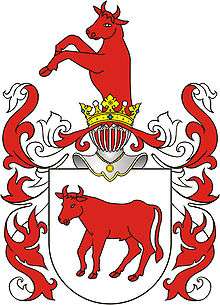 |
Ciołek | Stanisław of Brzeża (?) | Jan Eiviltas (Ewild) |
 |
Dębno | Dobiesław of Oleśnica (Castellan of Wojnicz) | Albrecht Kareiva (Korewa) of Sowgotsko |
 |
Doliwa | Maciej Kot (Castellan of Nakielsk), Janusz Furman (Castellan of Międzyrzec), Piotr of Falkowa |
Naczko |
 |
Dołęga | Unknown | Mantvilas (Monstywild) |
| Drya | Janusz of Tuliszków (Castellan of Kalisz) | Mikołaj Tautgirdas (Tawtygierd) | |
 |
Działosza | Unknown | Wołczko Rokutowicz |
| Gierałt | Mikołaj of Gorzków (Bishop of Vilnius) | Surgintas (Surgut) Reszyński | |
| Godziemba | Andrzej of Lubraniec (Judge of Kujawy), Andrzej (Pastor of Włocławek) |
Stanisław Butautas (Butowtowicz) | |
 |
Gryf | Unknown | Butautas (Butowd) |
 |
Grzymała | Domarat of Kobylan (Castellan of Biecz) | Jan Rimvydas (Rymwidowicz) |
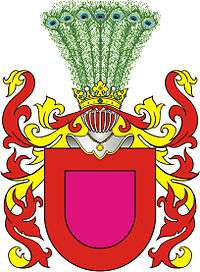 |
Janina | Maciej (Bishop of Przemyśl), Mikołaj of Suchodół (Judge of Lublin), Piotr of Tura (Judge of Łęczyca) |
Wojsym Danejkowicz (Danis?) |
 |
Jastrzębiec | Wojciech (Bishop of Kraków), Marcin of Lubnica |
Nirmedas (Nemir) (Starost of Polotsk) |
 |
Jelita | Klemens of Mokrsko (Castellan of Radom), Florian of Korytnicy (Castellan of Wiślica) |
Girdutis (Gierdut) |
 |
Kopacz | Unknown | Getautas (Getowd) |
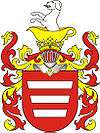 |
Korczak | Unknown | Czupa |
 |
Kot Morski | Unknown | Vaišnoras Vilgailaitis (Wojsnar Wilkolewicz) |
 |
Leliwa | Jan of Tarnów (Voivode of Kraków), Jadwiga of Leżenic |
Albertas Manvydas (Moniwid) (Voivode of Vilnius) |
 |
Lis | Krystyn of Kozichgłówy (Castellan of Sącz) | Jan Sangailas (Sunigajło) (Castellan of Trakai) |
 |
Łodzia | Mościc of Stęszew (Castellan of Poznań) | Mikusz Wilczkowicz |
 |
Łabędź | Dziersław of Skrzynna ? | Gelgantas (Goligunt) |
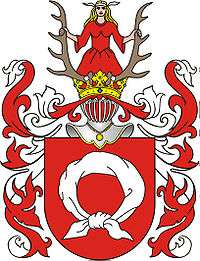 |
Nałęcz | Sędziwoj of Ostroroga (Voivode of Poznań), Mikołaj of Czarnków (Judge of Poznan) |
Koczan |
 |
Nowina | Mikołaj of Sepna | Mikołaj Beinoras (Boynar) |
 |
Odrowąż | Jan of Szczekociny (Castellan of Lublin) | Visgirdas (Wyszegerd) |
 |
Ogończyk | Wojciech of Kościola (Castellan of Brzeg), Mikołaj of Taczów |
Jerzy Sangraw (Sungaila) |
 |
Oksza | Mikołaj of Strzelc (Judge of Sandomierz), Klemens Wątróbka of Strzelc |
Minmantas (Minimod) Sesnikowicz |
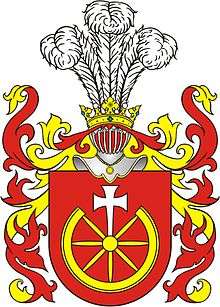 |
Ossorya | Mikołaj of Korabiowic | Tvirbutas (Twerbut) |
 |
Paprzyca | Unknown | Mažtautas (Mosztołd) |
 |
Pierzchała | Piotr of Włoszczowa (Castellan of Dobrzyn) | Daukšas (Dauksza) |
 |
Pobóg | Jakub Koniecpolski (Voivode of Sieradz), Piotr of Popowo |
Ralo |
 |
Pomian | Jan Pella (Bishop of Włocławek) | Stanisław Sak |
 |
Poraj | Micał of Michałow (Voivode of Sandomierz), Jaka (Judge of Kalisz) |
Mikołaj Bilminas (Bylimin) |
 |
Półkozic | Jan of Rzeszów (Bishop of Lviv), Jan Ligęza of Bobrku (Voivode of Łęczyca), Micha of Bogumiłowice (Castellan of Sandomierz), Jan of Bogumiłowice (Castellan of Czchów), Paweł of Bogumiłowice (Judge of Kraków), Marcin of Wrocimowice (Chorąży of Kraków) |
Wołczko Kovaldas (Kukwa) |
 |
Rawicz | Krystyn of Ostrów (Castellan of Kraków), Grot of Jankowice (Castellan of Małogojszcz) |
Mingailas (Minigajło, then Minigał) (Castellan of Vilnius) |
 |
Rola | Jan of Łąkoszyn (Castellan of Łęczyca), Mikołaj of ... |
Danguolis (Dangel) |
 |
Sulima | Stanisław Gamrat of Klimuntowic (Castellan of Połaniec) | Radvilas (Rodywił-Radziwił(ł)), then Radziwił(ł)owicz |
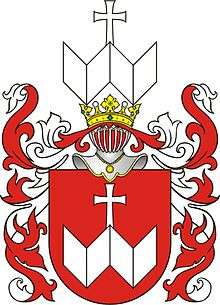 |
Syrokomla | Jakub of Kurdwanowa (Bishop of Płock) | Jonas Mingailis (Jan Minigel) |
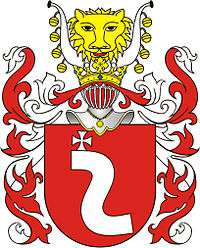 |
Szreniawa | Jan of Łańcuchów and Grodziny (Castellan of Zawichost) | Jotautas (Jadat) |
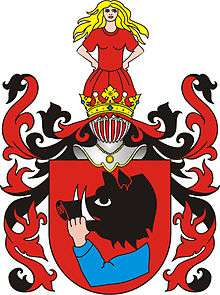 |
Świnka | Unknown | Andrzej Daukantas (Dewknotowicz) |
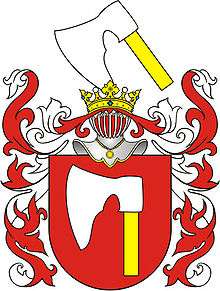 |
Topór | Maciej of Wąsosz (Voivode of Kalisz) | Jonas Butrimas (Jan Butrym) of Żyrmonów |
 |
Trąby | Mikołaj Trąba (Archbishop of Gniezno) | Kristinas Astikas (Ościk) |
 |
Trzaska | Unknown | Vaidilas (Wojdyło) Kuszulowicz |
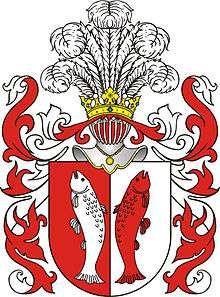 |
Wadwicz | Jan Mężyk of Dąbrowy | Petras Mantigirdaitis (Montygerd, then Montygerdowicz) |
 |
Wąż | Unknown | Koczan Sukowicz |
 |
Zadora | Zbigniew of Brzezia (Crown Marshall) | Jaunutis Valimantaitis (Jawnuta Wolimuntowicz), Voivode of Trakai (from his younger brother Mykolas Kęsgaila the Kęsgailos family descended) |
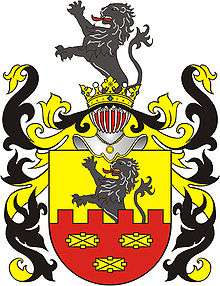 |
Zaremba | Jan of Królików (Castellan of Gniezno), Marcin of Kalinów (Castellan of Sieradz) |
Gintas (Ginet) Konczewicz |
References
- 1 2 3 4 Simas Sužiedėlis, ed. (1970–1978). "Horodle, Union of". Encyclopedia Lituanica. II. Boston, Massachusetts: Juozas Kapočius. pp. 443–444. LCC 74-114275.
- 1 2 3 4 5 6 7 Kiaupa, Zigmantas; Jūratė Kiaupienė; Albinas Kunevičius (2000) [1995]. The History of Lithuania Before 1795 (English ed.). Vilnius: Lithuanian Institute of History. pp. 154–155. ISBN 9986-810-13-2.
- 1 2 Stone, Daniel (2001). The Polish–Lithuanian State, 1386–1795. A History of East Central Europe. University of Washington Press. pp. 10–11. ISBN 0-295-98093-1.
- ↑ (in Lithuanian) Ivinskis, Zenonas (1978). Lietuvos istorija iki Vytauto Didžiojo mirties. Rome: Lietuvių katalikų mokslo akademija. p. 319. LCC 79346776.
- ↑ Urban, William (2003). Tannenberg and After. Chicago: Lithuanian Research and Studies Center. pp. 195–196. ISBN 0-929700-25-2.
- ↑ (in Lithuanian) Ivinskis, Zenonas (1978). Lietuvos istorija iki Vytauto Didžiojo mirties. Rome: Lietuvių katalikų mokslo akademija. p. 367. LCC 79346776.
- ↑ Subtelny, Orest (1988). Ukraine: A History. CUP Archive. p. 49.
- 1 2 Simas Sužiedėlis, ed. (1970–1978). "Administration". Encyclopedia Lituanica. I. Boston, Massachusetts: Juozas Kapočius. pp. 17–21. LCC 74-114275.